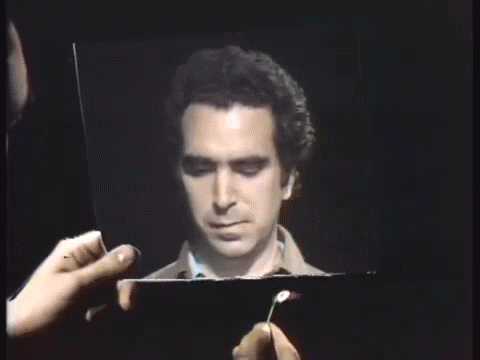
‘Peter Campus, a pioneer in the development of video, has said that his ‘Eureka’ moment came while watching the first Apollo moon landing in 1969. From a beach cottage in New England the artist experienced the dislocation generated by simultaneously witnessing the familiar sun-dappled ocean scene before him and the other-worldly event unfolding in black and white on his TV. Both were undeniably real, both were occurring at the same moment, yet each appeared to negate the primacy or plausibility of the other.
‘In an age when most people who live in big cities can expect to be photographed, monitored or videotaped hundreds of times a day, it is hard to imagine a time when video was new. Because it is not just a medium of recording, but can also feed a stream of live images of anything to anywhere, video not only radically changed the average person’s self image, but also altered forever our collective perception of time, duration and the idea of a fixed perspective.
‘Inspired by Bruce Nauman and others, Campus experimented with video in the early 1970s, initially with camera obscura-like installations that demanded the perambulating presence of the viewer. At the same time he made projections addressing video as a kind of displaced mirror, and using himself as test subject. This show provided a mini-overview of these early works, as well as examples of his later Polaroids – a static medium as close to the ‘live’ reflectivity of video as still photography can get – and recent video works made with the latest digital tools.
‘Three Transitions (1973) demonstrated Campus’ talents as a sort of video Houdini who, while executing various subdued performative tasks and supervising his actions via an off-camera monitor, is intent on exposing the perceptual assumptions that allow the spectator to be fooled. In short episodic clips he made ample use of the blue screen process, a technological breakthrough allowing one live image to be inserted into the background or foreground of another. The technique became ubiquitous to the point of invisibility in television production, but in the early 1970s it was still new, and Campus exploited it to examine the mechanisms by which points of view are constructed.
‘His first ‘transition’ showed the artist approach a large paper screen, his back to the camera, and carefully make an incision in its surface. The gash immediately appears to rip open the rear of his corduroy sports jacket, from which protrude Campus’ tearing fingers. In a flash the viewer realizes that the artist is actually standing on the far side of the partition, the near side acting as blue screen, and that two cameras on either side are recording and combining both images in real time. In another projection, Four Sided Tape (1976), a man’s torso is methodically deconstructed by hands emerging from behind the screen on to which the image is projected. Even simpler is Third Tape (1976), in which a jumble of mirrored tiles is slowly placed on a table-top, the random heap reflecting a fragmentary portrait of the face of the person performing the act, one that is continually in flux.
‘This fragile construction and annihilation of images as a metaphor for the tenuous construction of self are a constant in Campus’ work – hence all the destroyed paper screens (he burns one of them in another video), layered images, mirror shards and ephemeral reflections. Campus intentionally never used video cameras with viewfinders, but relied instead on the monitor as a surrogate eye, disrupting the notion that the lens represents the privileged vantage point of the self. Despite Rosalind Krauss’ claims concerning the intrinsic ‘narcissism of video’, this scattering of perspective implies a lack of centrality for both artist and observer.
‘The strain of melancholic self-reflection in Campus’ projections also permeates his high contrast, black-and-white Polaroid portraits from the late 1970s and 1980s, made during a 17-year hiatus from video. Again he used the idea of instantaneous photographic feedback as a reflective surface, and the portraits evolved through a process of collaboration with each sitter. Typically, he would take an initial photograph and show it to his subject, whose emotional response to the image would register and gradually alter the appearance of each successive shot.
‘On viewing the new DVDs made since his return to video in the late 1990s, one’s first inclination is to think that Campus has gone all soft and sweet. Presented on small flat screens, his digitally edited loops are beautiful in a way that his early work never was. Assembled using crisply phrased and montaged clips – a muddy path in the woods, a gardener pulling weeds, an index finger tracing the path of an electrical cord – they exude enough lyricism to make one downright suspicious. But repeated viewings of the lushly hypnotic works begin to erode such wariness, and what remains is a more finely gradated and personal elaboration on Campus’ doubt about the stability of images and identities.
‘In Divide (2001), a humming-bird fluttering in slow motion over a blood-red feeder is spliced together with an image of the empty corner of a room. The marriage of the two apparently unrelated realities eventually proves too fragile to be sustained, and the bird’s image is wiped away like chalk from a blackboard, leaving only a dead, sun-bleached interior. To some degree there has always been both a terror and acceptance of the transitory nature of vision in Campus’ work, which may simply be growing more richly dream-like as his images come closer to home.’ — James Trainor, Frieze
____
Stills

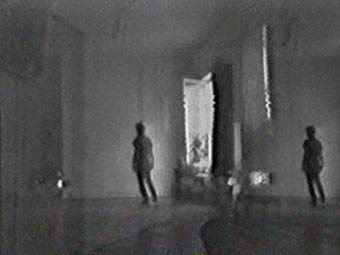








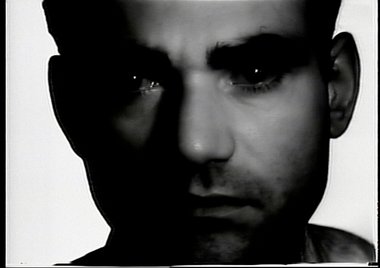






















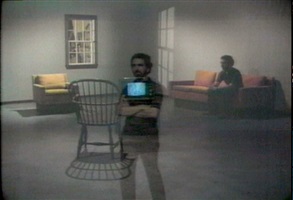




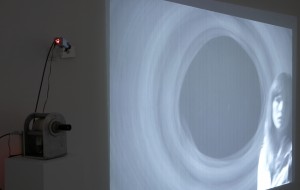

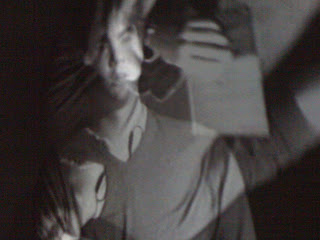






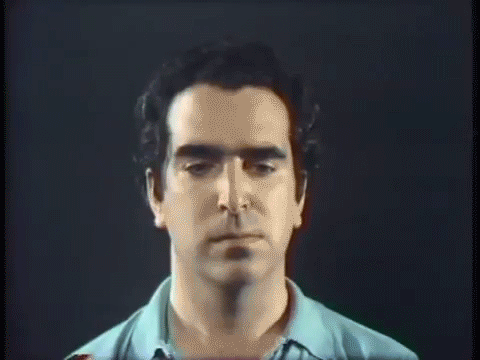
_____
Further
Peter Campus Website
Peter Campus @ Cristin Tierney Gallery
peter campus video ergo sum
Peter Campus on his most famous work and why he hates it
PETER CAMPUS: IMAGE AND SELF, by Bill Viola
Book: ‘Peter Campus’ (les presses du réel)
Les vidéos désarmantes de Peter Campus
PETER CAMPUS, TROUBLE FACE
Video: Peter Campus Presents His Version of the Star-Spangled Banner
Peter Campus : Quand l’Amérique ne reconnaît pas un de ses génies
PETER CAMPUS: EXISTENTIALISM AND A HALF-LIFE IN VIDEO
Peter Campus: When America fails to recognise one of its own geniuses
_______
Extras
Peter Campus, The Artist Studio
Peter Campus at Jeu de Paume, Concorde – Paris / Portrait filmé
Excerpt: Peter Campus exhibition “Before this Moment”, and documentary
peter campus: notes on landscape
________
Interview
from BOMB

John Hanhardt Do you feel there was a movement from the exploration of the inner self in the Three Transitions videotapes, for example, to an exploration of the self as a reflection, to a cognitive exploration of the self as in the series of installations: mem and Shadow Projection? It would be interesting to know how you locate that shift from video to still photography.
Peter Campus For me what was important was not the switch from video to photography, but from the interior to the exterior. The interior examinations became overwhelming. Particularly the photographic series I did of faces that showed in Cologne and Berlin—which were very stark and severe. They came after Head of a Man with Death on His Mind, this projected, silent, barely moving, black and white image of a man’s face staring at the camera. I went from that video projection piece to photo-projection pieces called Man’s Head, and Woman’s Head [1979], high contrast black and white Polaroid photographs produced in the studio. They continued that idea of confrontational imagery and it just became too much for me. I had to stop. So I started looking at an industrial, burned-out landscape. I found the exploration not so different in a way: those first landscape pictures were harsh. Then I turned to bridges, Bear Mountain Bridge, the Roebling Bridge on the upper Delaware River. Finally, from there, I went into nature. But I was still looking for what I called “resonance” in what I was feeling. I wouldn’t go out to photograph a tree or a stone or a rock; I never felt that the subject of my work was trees, rocks, or stones—I felt that they were in many ways a continuation of my internal examination, that they were reflecting my mood in nature. The difficulty is that often that’s not what’s communicated. It is subtle and not direct. Often people misunderstand work, or, let’s say it’s expected that people have different interpretations than I do of my work. The nature pieces with the 4×5 camera were received very differently from the way I saw them.
JH I remember the response was that they recalled 19th century photography and its rhetorical form of image making, black and white photography of the natural landscape shot with a large-format camera. This idea of interior looking that you just referred to brings me back to something fundamentally important about your work: how you think about looking is translated and motivated by the different media you’ve worked with. The relationship between the single-channel videotapes from the early ’70s, the exploration of time as a means to compose and construct the image, and the viewer’s participation within interactive man-made environments that shatter projection have lead toward a refined understanding of the medium, both in its placement in an art historical discourse and in the viewer’s reception of it. I’m trying to construct that movement through traditional photography into digital image making and recomposing the still image by using new media, creating a new kind of representation, and your eventual return to video and the moving image, this time using digital techniques. This is one of the most extraordinary sequences embodied in an individual artist’s work in the late 20th century. It’s all so encompassing, profoundly investigatory and powerful. Can you discuss shifts that you made between these two different media—video and photography—and how you felt you were changing the media, or what issues you were responding to?
PC I probably wouldn’t have felt comfortable saying this five years ago, or maybe even now, but often emotional necessity overrides intellectual necessity. In the ’80s, it was necessary for me to be in the woods, at least part of the time. I needed to look backward from the present instead of forward. I needed to work in classical photography. I tried to keep the investigation, at least the emotional aspect of the investigation, somewhat consistent. It obviously couldn’t be, but I was trying to carry that along into nature. By working in digital photography, I found I was able to more directly explain what I wanted to say. It wasn’t through the subtleties of the photographic medium, but by direct intervention, placing images in direct correspondence one to another. Because of digital imaging, I was able to reconstruct and change images more convincingly than I was able to do in straight photography. I would never give up the eight years that I spent in large-format photography—it was great, and crucial, in fact, for setting up the digital phase.
JH Peter, I’m looking at this as a historian, and as somebody examining the different stages of a career. One can impose a conceptual grid on that by saying you were moving from one type of formal invention, one set of strategies, to another as you have moved through these different media. But that is not to say that there isn’t a profound engagement with yourself.
PC The most important thing for me is to find myself in my work, in the context of the present.
JH So, this conceptual way I’ve been talking about your work shouldn’t overshadow the power of that work, which is how it reveals the self. Whether it’s layers of the body being exposed in Three Transitions; the reflection of the viewer through projected closed-circuit video in the installation works of that period, such as Kiva [1971] and Stasis [1973]; or the turn to nature and the subsequent presentation of the projected video still-image, Head of a Man with Death on His Mind that shows the surface as somehow speaking to the interior, to the profoundly emotional and the cognitive. In the nature photos I see this as a powerful compositional moment. It is a turn outward, an interpretation of the natural landscape that gives the work significance and power. The digital imagery raised another set of issues in terms of composition—your use of color and the development of aesthetics, the images of pure beauty you were using in the ’90s, such as Stuff [1994], and in other digital collages of found images and of objects drawn from nature. That has continued in Mont Désert, the sets of videotapes that marked your return to the moving image and has continued into your most recent work. I’d like to focus on that transition to the idea of the beautiful image, which is partially located in nature but also, fundamentally, in the reflection of yourself in nature. So many of the images you were composing digitally and that you brought to video recently, include yourself; your partner Kathleen; your loved ones; people who are important to you. That feels like a very conscious change. Is it?
PC I’m not sure that there is a direct way to answer—I wouldn’t even call that statement a question. (laughter) It’s almost to the point of why I’m an artist. I had a very dramatic childhood—with the death of my mother and living in seclusion. Art—painting—was a way to get out of it and to communicate some of what I was feeling. As I went through college and studied psychology and then went on to work in the film business, art became an exalted dreamlike place. I’ve almost managed to keep it that way for the 30 years I’ve been doing it. I would say my reasons for making art haven’t changed that much—the most basic reason was to communicate what I couldn’t communicate any other way. That doesn’t deny that when I first entered video, I was really excited by what video specifically was—not necessarily broadcast video—but how this invention that pretty much coincided with my life could be used to make art. The first use of television was 1936 or 1937.
JH And the PortaPack was introduced in 1965 . . .
PC I didn’t use the PortaPack at first: it seemed to me not video. It seemed related to the film camera. To me, pure video was made with cameras you couldn’t see through; they were surveillance cameras. I constructed open camera pieces that were interactive.
JH With the projection?
PC People would actually enter into the projection and interact. I see a lot of work now that’s called interactive—the interactivity is to press a button or set off a series of sequences by moving this way instead of that way. But the projection really engaged the viewer to become, literally, a part of the piece.
JH But didn’t it also reflect and represent the viewers, causing them to see themselves in other, new ways?
PC Each piece proposed that you see yourself in a slightly different way from this perspective and to coordinate that with another view of yourself.
JH So does this fusion of the cognitive and the psychological come out of your own interest and studies? Your own kind of recovery of yourself through art?
PC Right.
JH That was what you were communicating in those first pieces. With what communities were you exchanging these ideas?
PC As an artist, I was very aware of what was going on with me; but as a person, I’ve always been reclusive. I was influenced by Bruce Nauman’s work, shown at the Castelli gallery in 1969. That set my work on track. They were single images in an installation situation that were hour videotapes of repetitive movement. They were extraordinary. I still think they’re extraordinary. They talked about the very potential of the medium. There was the other direction I did not go in, which was similar to, let’s say, Nam June Paik—where there would be a montage of images. A barrage of images. Where the idea was—I think the idea was—that the image wasn’t as important as the situation.
JH It was a total experience. When we look at the early ’70s and late ’60s, there was an enormous range of activity in video. There was work within performance, body art, conceptual art, there was Paik, image processing, there were community-based video collectives . . . and it was all happening at the same time. Were you aware of all that? Were you also aware of Michael Snow’s films and film installations? Were you aware of Paul Sharits’s films?
PC Definitely. He used to be at Millennium Film Archives. There used to be showings most evenings: Stan Brakhage, Ed Emschwiller, Bruce Conner . . .
JH The Bykert Gallery showed installations later.
PC And I first showed at Bykert.
JH So you were aware of the culture of the moving image and installations; these were all things that you were conversing with.
PC Right, very much so. Very interested. Aldo Tambellini’s Black Gate Theater in New York.
JH I’m trying to recover that whole history in terms of exhibitions and writing. It’s become very restricted—there are just one or two slices that people are aware of. It is an effort to put it all back together again and see the cross-movements between the work that was being done then—documentary, image processing, conceptual, performance, installation work for television—and the work being created now. When I lecture today, I show your videotape Three Transitions. Viewers seeing that work for the first time are shocked by its transformation of the body and face in the pieces employing chroma-key, two-camera setups. It provokes people to think about portraiture in new ways. When one sees your installations in museums and galleries, displayed alongside new work by younger artists, one really sees them as a powerful resource: the precedent to this whole new generation starting to work with video.
PC Many of them have never seen the work of their predecessors.
JH Yes, but you are one of the teachers.
PC NYU, where I teach, is just beginning to introduce the idea of history in video.
JH Don’t you think that comes through in your teaching: the fact that your work informs the work your students are making now?
PC No. My strength as a teacher is being able to see what the student is trying to do and help him or her to move on with it. I know a lot of people present their ideas to the students; I’ve just never been that kind of teacher. Most places where I’ve taught have had almost no sense of history. In the lecture that you gave at the Guggenheim downtown where you linked film history with video history—that seemed so key. After seeing your lecture, I started showing films in my classes thinking, Yes, of course, this is obviously right. Why do we think of video as being separate from the rest? It’s helped tremendously, allowing us to talk about montage editing, and sequencing, and also, to a lesser extent, what’s going on in movie theaters. Talking about what’s going on in the movie theaters leads us to talk about what is going on in the galleries. What is installation art? For example, in a class last night, a student tried to describe a video piece that she saw at DIA, and she was only talking about the images. I said, “Wait a minute, tell me what you saw in that room. Was the room dark, was the room light? What was this image projected on? A wall? A screen? Where was this image coming from, was it from a projector? Where was the projector? If you walked into a room and saw a piece of sculpture, you would be able to describe every bit of it. But you walk into a video installation as though the equipment isn’t there.” Strong exceptions are works that began to show up five years ago; Gary Hill is really using the equipment as part of the installation—and Tony Oursler.
JH What I think has been central to the art of the 20th century has been the movement of the moving image from film through video, electronic media and television, to the Internet, digital imaging, Web sites, CD-ROM, and DVD. The expanding place . . .
PC Well, we don’t know about that last part.
JH But the web is a place where you can capture the moving image.
PC We don’t know yet. I work really hard to get good quality; the quality of the web is awful. Maybe that will change.
JH Technically, it’s a quality that can still be exploited. Remember, back in the early ’70s, black and white video was reel-to-reel. It was seen as poor quality in comparison to film. Yet it was a different medium, and artists exploited and explored that difference to create an art form out of video. Following that line of argument, I would say that there is a quality of difference that can inform it, but still have this continuing basis of the moving image—which I think is a powerful trajectory.
PC That is how we should think of it. To some extent, I was surprised with the way that Bill Viola was talking about the death of video—that it will only be part of some small period of time. But yes, it is time to think in terms of just the moving image. The trouble with that is the dominance of movies in our culture.
JH Right. There is a profound difference between independent media artists working with film and video, from television production and the mainstream film industry. Those are the issues that you’re talking about with your students: How do you describe what you see? There are also the narrow art-historical paradigms: art historians who don’t deal with the moving image and film historians who don’t deal with art installation. We need to give the study of the media arts a theoretical basis of understanding and interpretation. That is what is so exemplary about your career, Peter—this movement, the basis and understanding of film and the movement through video. Three Transitions, in which you employed chroma-key in the television studio, was done at the WGBH-TV lab in 1973.
PC With the technicians screaming out of earshot, “What is this? Why are we doing this?” (laughter) And the producer, Fred Barzyk, saying, “What is this crazy person doing?”
JH Where do you place your moving image work from the early ’70s within this historical trajectory through different media? Was it somehow linked to your work in the early ’90s, when you began to move back to video and the moving image?
PC ’94, ’95.
JH The 20 year interim from 1973 to 1994 preceding your return to video was filled with photographs and digital images. What brought you back to the medium? What was the quality of that experience, and what was the difference over time? It felt like there was a rediscovery.
PC It’s hard to answer those questions because they are so deep in my psyche. They’re buried down in there. Now that I’m back working in video, I know that’s my real love, that’s what I feel comfortable in. In a sense, it’s what I was trained in. I went to film school. I don’t entirely know what my reasons were for stopping the video work, I’ve given lots of glib answers and some not so glib . . . the easiest answer is that I wanted to stop working in the moving image. There were other things going on. It was nine years of a lot of frustration; I felt that I was successful at it, and yet there wasn’t any way to support myself. Subsequently, I went into teaching. At this point, I probably regret giving it up, but there was this monetary drawback, and I was feeling that drawback all the time.
___________
12 of Peter Campus’ 83 works
_________
Kiva (1971)
‘Kiva–the title refers to a kind of ceremonial room used by Native Americans of the Southwest for ritual and spiritual ceremonies–comprises a monitor with a closed circuit camera mounted on top; the lens is pointed directly at the viewer of the monitor, but the camera’s view is restricted and manipulated by the placement of suspended mirrors. The camera shoots through a hole in one mirror to the surface of the other, both constantly shifting in relation to each other as they turn like a mobile. The mirrors fragment and multiply the image, allowing the camera to take in aspects of the room, the viewer, and the eye of the camera itself.’ — University of Michigan
My Experience of “Kiva”
______________
Interface (1972)
‘A sheet of transparent glass is set up in a darkened room. On the wall behind this sheet of glass there is a closed-circuit video camera, directed towards it. Four metres in front of the camera there is a video projector which projects the live video signal from the camera onto the sheet of glass. When the visitor moves into the recording area in front of the transparent glass surface, his/her reflection – the wrong way around – and his/her video image – the right way around – appear on it simultaneously and life-sized. Depending on where the visitor is standing, the two images are visible either next to each other or partially overlapping.’ — Slavko Kacunko
Experience
Experience
_____________
Three Transitions (1973)
‘Three Transitions is one of the seminal works in video art. It was conceived in the decade of Peter Campus’ greatest creative intensity and thanks to its pioneering nature it has become one of his most widely known works. The video consists of three short exercises or “transitions” in which Campus employs different visual and spatial effects. Throughout the video, the artist displaces and superimposes takes of his own body, which he makes interact with each other using chromo-key techniques. Three Transitions set up many of the paradigms used recurringly by Campus from that point forward, particularly his self-absorbed position as subject and object of the image, and also the use of video resources to contemplate perception and self. The making of the video coincided with Campus’ visit to Boston as an artist in residence of the experimental program New Television Workshop, sponsored by the public broadcasting network WGBH. The innovative philosophy of WGBH led it to develop a policy of active support for visual experimentation by artists of the first generation of video art.’ — Museo Reina Sofía
______________
Shadow Projection (1974)
‘Encountering one of these pieces in person is a haunting, unforgettable experience. The room is dark and its dimensions unclear. A glowing pale blue rectangle of light illuminates one wall. As you approach, the rectangle suddenly comes alive with a disorienting burst of light, movement and shadow. Quickly you realize that you are seeing your own image projected live on the wall in black and white. You look at yourself as if seeing a ghost. The pale, fragile quality of the light and tenuous consistency of the image speak of impermanence. Then, as in most unexpected encounters with your own likeness, you discover that you are not what you seem to be.’ — Bill Viola
Peter Campus discusses his work Shadow Projection
__________
R-G-B(1974)
‘Writes Campus, “My most dryly stated tape, free of insinuation, [R-G-B] is simply the exploration by a performer of the color system in which he is trapped, much like a prisoner pacing off his cell.” Campus the performer creates a self-portrait within the technical system, transforming video space as he manipulates color physically, mechanically and electronically. Staring directly into the camera, he first places multicolored gels on the lens, then projects slides of pure color. Exploring video’s electronic color system, he points the camera at a monitor and adjusts the color switches, creating a chain reaction, a video “hall of mirrors.” Finally, he totally immerses his figure in saturated fields of electronic video color, his body ultimately submerged in the technology.’ — letterboxd
Excerpt
_____________
Head of a Man with Death on His Mind (1978)
‘In Head of a Man with Death on His Mind [1978] the artist video-recorded the still face of actor John Erdman. Through framing and lighting, the face is subtly transformed to become a stark dramatic presence. The vaguely threatening quality is enhanced by the barely visible movement of the recorded image. Thus the portrait has a heightened psychological power, breathing life of its own.’ — John Hanhardt
Excerpt
__________
circa (1987)
‘Around 1987 Campus began a series of large-scale projections of shells and stones that recalled his series of faces and his photographic work. This new series united and clarifed the underlying logic behind what had previously seemed disparate activities. They provide barely enough light for visitors to manoeuvre, transforming the space into a sort of maze in which each rock, its outlines hazy, floats on a black field that seems to extend ad infinitum. It is impossible to intuit their scale. Surface details dissolve into abstract patterns of ridges and divots, speckles and bands. Blacks read as negatives, greys as positives, indicating that some materials reflect more than others and underscoring that what we are seeing is ultimately not an object but light. What is important, then, is not the rocks or the images thereof, but the spaces around them: the field of the projection that isolates them, the room in which the works are presented and the darkness with which they visually merge. Viewing becomes a spatial, physical experience that compresses the geologic time implied by the surface details of the stones, a hint of some past process of erosion or eruption, the photographic moment at which each object was recorded and the transitory duration in which the images are presented and seen.’ — ArtReview
Excerpt
______________
barn at north fork (2010)
‘barn at north fork involves the frontal image of a barn that gradually mutates in color. This work not only modulates the flow of time but break up the image’s visual continuity with large rectangles of subtly changing colors that recall the early seascapes of Mondrian, or those of Nicolas de Staël.’ — The Brooklyn Rail
Excerpt
_____________
catamaran (2011)
‘In his recent video work, he makes use of digital techniques to work on the image, pixel by pixel, rather like a painter. Using an extremely high-definition digital camera, Peter Campus pursues his current work.’ — Paris Photo
______________
red fence (2013)
‘As expanded possibilities of digital editing lured Campus back to video, he reconciled the pictorial and durational components of his art in “videographs”—hybrids of photography and video featuring extended, technologically enhanced still shots. They cultivate heightened attention but offer no particular focus.’ — The Brooklyn Rail
Excerpt
______________
nap flower lamp (2015)
‘As the preternatural clarity of the new work updates the uncanny, technological magic of his earliest videos, Campus continues to render the world through the filter of video. Linking past and present, his projections of stones in particular, and their fusion of personal and geological time, assume new poignancy in light of the earth’s uncertain future.’ — The Brooklyn Rail
Excerpt
_____________
Convergence d’images vers le port (2016)
‘Convergence d’images vers le port, a work commissioned for Campus’s current Paris retrospective, features extended shots of coastal scenes, simultaneously projected on all four gallery walls. Campus describes it as “anti-cinematic,” since it obliges us to shift attention across the walls. Animated by subtle movements of water and the labors of fishermen, the clips fade into black and white as they end—an allusion to the origins of video and photography in black and white, but also an intimation of mortality.’ — The Brooklyn Rail
Excerpt
Excerpt
*
p.s. Hey. ** David Ehrenstein, Hi, David! ** Misanthrope, Hi, George. I think basically your interpretation of the girlfriend vs. boyfriend thing is entirely correct. Hm, interesting about those reactions. I only get that when it’s people I know for some strange reason having nothing to do with us being natural friends like, say, with members of my family. That’s life, yes. I don’t think of you and me as guys who don’t agree on things, how weird. However, if there’s anyone with whom I don’t think I agree about anything, it’s probably Joe Mills. ** S., Hi. Not a big London fan myself, but it’s a major joint. Even in my pre-16 years old non-vegetarian phase I hated fish and seafood and refused to eat it, strange. ** _Black_Acrylic, You are back, it’s true, hi! That Eleanor Elks Herrmannsen sculpture is nice, I dig it too. Is ‘Dream Deceivers’ the doc about the boy who blew his face off and the trial and stuff? If so, yeah, I remember that being strong. I don’t know if I ever read that Levene/Bladh interview. Cool, thanks! Everyone, Don’t let the week begin without reading this interview with weekend co-star Martin Bladh conducted by Infinity Press author and former DC’s d.l. Shane Levene, which comes courtesy of Mr. _Black_Acrylic. ** Nemo, Hi, Joey. I’m good, thanks. And thanks a lot for the hook up with Sue’s new videos. Just the other day I was thinking/saying how painfully long it has been since I’ve seen new work by her. And she uses a poem of mine in the new work?! That’s news to me. Cool. It wouldn’t be hard to rival my collages, and they certainly did and beyond. You need to tell Jarrod hi right back from me too, please. Love, Dennis. ** That’s it?! Wow, where is everybody? Huh. Well, Peter Campus has a retrospective up here in Paris right now, and it was the most interesting/inspiring show/work I’ve seen in a long time, so, naturally, I made a post to try to share my enthusiasm. Unfortunately, much of his work doesn’t transfer very well at all to this kind of representation, but you can get hints and start your hopeful investigation into his work today at least, if you like. See you tomorrow.




 Now available in North America
Now available in North America 
Campus’ work sounds intriguing, and I will investigate the links. Funny how my big film for the day is an Iraqi film in which the director gave a video camera to a director who continues to work in a town increasingly threatened by ISIS, so he could document this. (I’m writing about it as part of an article on the Human Rights Watch festival.) I wonder what Peter Campus would think of this use of video.
My meds are not really working out as far as treating the depressive part of bipolar disorder, although they’ve calmed me down considerably. I told my doctor, and he thinks I need to try something different. I E-mailed his receptionist about making an appointment for this week, and when I get home from the film (it’s a 10 AM screening), I hope to have a message from her about that.
“to a doctor…,” not director.
Hi!
Thank you for today’s post! I’ve been looking forward to it since you mentioned that you saw the retrospective. And also: thank you for Saturday’s! Darkleaks looks thrilling!
I’ve had a pretty busy few days. (And ones with unbelievably shitty internet connection – that’s the main reason why I “disappear” sometimes.) On Saturday we held our fourth trans self-help group which wasn’t outright terrible but… well, it wasn’t too great either. I’ll meet the psychologist with whom I co-lead it on Thursday and we’ll talk about our experiences and (hopefully) we’ll come up with a few new ideas/plans/techniques we can use in the future. Then I started cleaning and rearranging my room which is a must-do I’ve been postponing since forever, haha. And, and I guess this is the highlight of my weekend, I started working on the first edited version of my book which means that I think I’m finished with the actual text. It’s so very exciting!!
How was your weekend? Did you see something great at the Night of the Museums (we do have it here, indeed)? Was today the first day of the editing works? If so, how was it?
I hope you’re well and everything’s swell there!
Peter Campus hails from a time when video was seen as a formunto itself. Nowadays all audio-video and film work is regarded on the same level and fights for space in the public consciousness.
With the “Encores” revival of “The Golden Apple” and a full-scale biography coming in November would it be possible for you to bring my “John LaTouche Day from your old blog Back From The Dead, Dennis?
Hi DC,
The Peter Campus stuff is great, thanks for the tip off. Love the sense in the first transition of one image tearing through another, and the recent work is such a stark contrast. I also really liked in the interview where he said that the decision to change medium was led emotionally rather than conceptually. So much art I see these days is so academic in a certain sense, the artist has a clearly defined practice and clear concerns and enquiries; the work is often very interesting but it’s as though it’s lost all sense of desire. I actually nearly took a masters in moving image and bottled it 3 weeks before because this tension was playing on my mind so much.
Thanks for your encouragement. It’s funny how you can feel so frustrated and the next day you get up, get to work, and very gradually start to realise what needs to be done. Almost as if the process provides its own reassurance. Would you say that writing a film has been similar to writing work for theatre? Actually, how similar is it to writing your GIF works? Telling a story through images, visual continuity, etc…
On that note – do you know if the ventriloquist’s convention is coming to Lisbon? I’m sure I saw somewhere that it was but double checking the website there doesn’t seem to be anything.
TC
I was unaware of Peter Campus until today, so thank you for this introduction. He has an interesting story to tell about the course of his thinking.
Had the day off work so I watched 3 episodes of the new Twin Peaks series. I’m very happy to report that I love it, and the gist I get from online is that it’s gone down a storm with pretty much everyone else too. Very much on the abstract Inland Empire side of the Lynchian universe. Happy also that there’s another 15 installments still to come.
Hey Dennis – Been away from the computer and out of town for a bit. Mostly a good thing. I’ll be catching up on the blog over the next few days. This Peter Campos day looks intriguing. Do you know if the French show is coming over the U.S. at all?
I loved the “Dunce Codex” (great title) GIF piece. The ending sequences made me laugh out loud. I loved how yellow was used throughout and the way the GIFs often interacted with the images directly above and below. Those moments of narrative/commentary felt really seamless. I know you’re hardly swimming in time, but have you revisited the idea of writing about your GIF work?
Do you have access to the new Twin Peaks? I’ve seen the first 3 episodes and I suspect you’d flip out for it. It’s much closer to ‘Inland Empire’ than anything else he’s done, with echoes of ‘Eraserhead’ and even his early shorts. The TV series seems more like a reference point and launching pad for something new. So far, it’s hardly a return to that universe — which is strange given the built up. Most of the show isn’t set in Twin Peaks, doesn’t feature the characters, or tap into the show’s sensibility. But it is pure Lynch, no question, with some truly revelatory and wild sequences.
I was introduced to Campus’s work when I was back in school but never followed up, so this is great for me.
Been trying to get my thoughts together on Dunce Codex, which I think is great. I often find myself working with that color, for some reason it’s usually at the end of a process of elimination. Yeah, will maybe say more later.
Dennis, Hmm, I think that you’re probably right about this not being the best format for Campus’ work, however, I think it’s more than appropriate for an introduction/initiation. I like the stuff I see here. Of course, I wonder what his work means in the age of CGI. Or not “means” but how it survives, so to speak, if that makes sense.
Yeah, you and I do oddly agree on a lot of things. At least we have in the past and I’m sure we will in the future. I was just making a silly joke there.
I get it from family, as well. The friends I’ve gotten it from are people I’ve really met for the first time or two, people who haven’t really been around people like me a lot and have these kind of misconceived misperceptions about me until finally one very soon after meeting them, they realize all those things were total shit and that we’re just regular ol’ people like anyone else. If that makes sense.
So let me ask you: novel. Fiction writing. You had been working on something quite a while ago, something that at the time was very personal and raw, got a bit stuck, and then took it in a new direction and were really happy with that new direction. Are you still working on that?
Hey,
Here’s a new thing by James Nulick at Fluland (which is pretty much my favorite lit site now): http://www.fluland.com/2017/05/22/sidewalk-pentagrams-james-nulick/